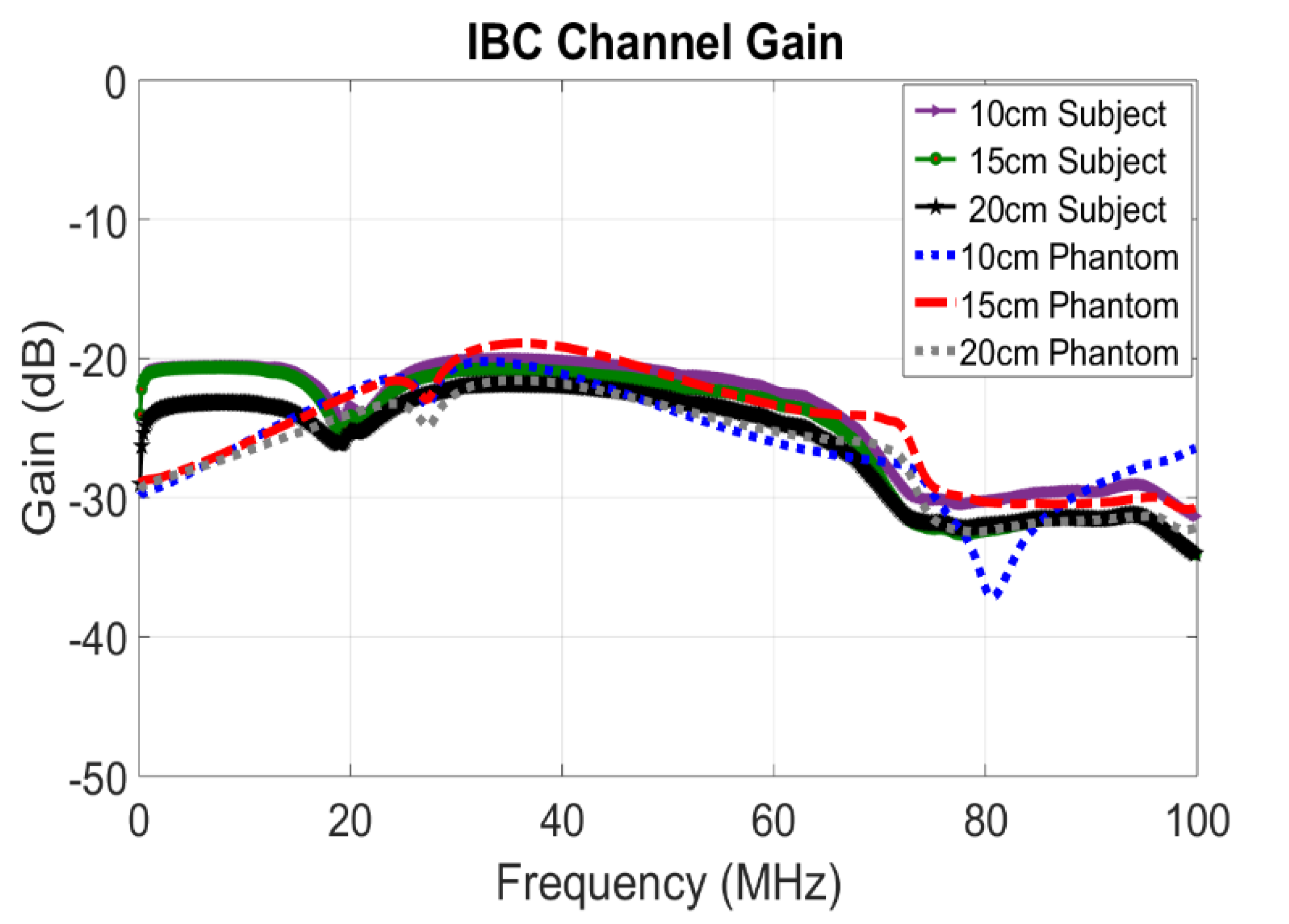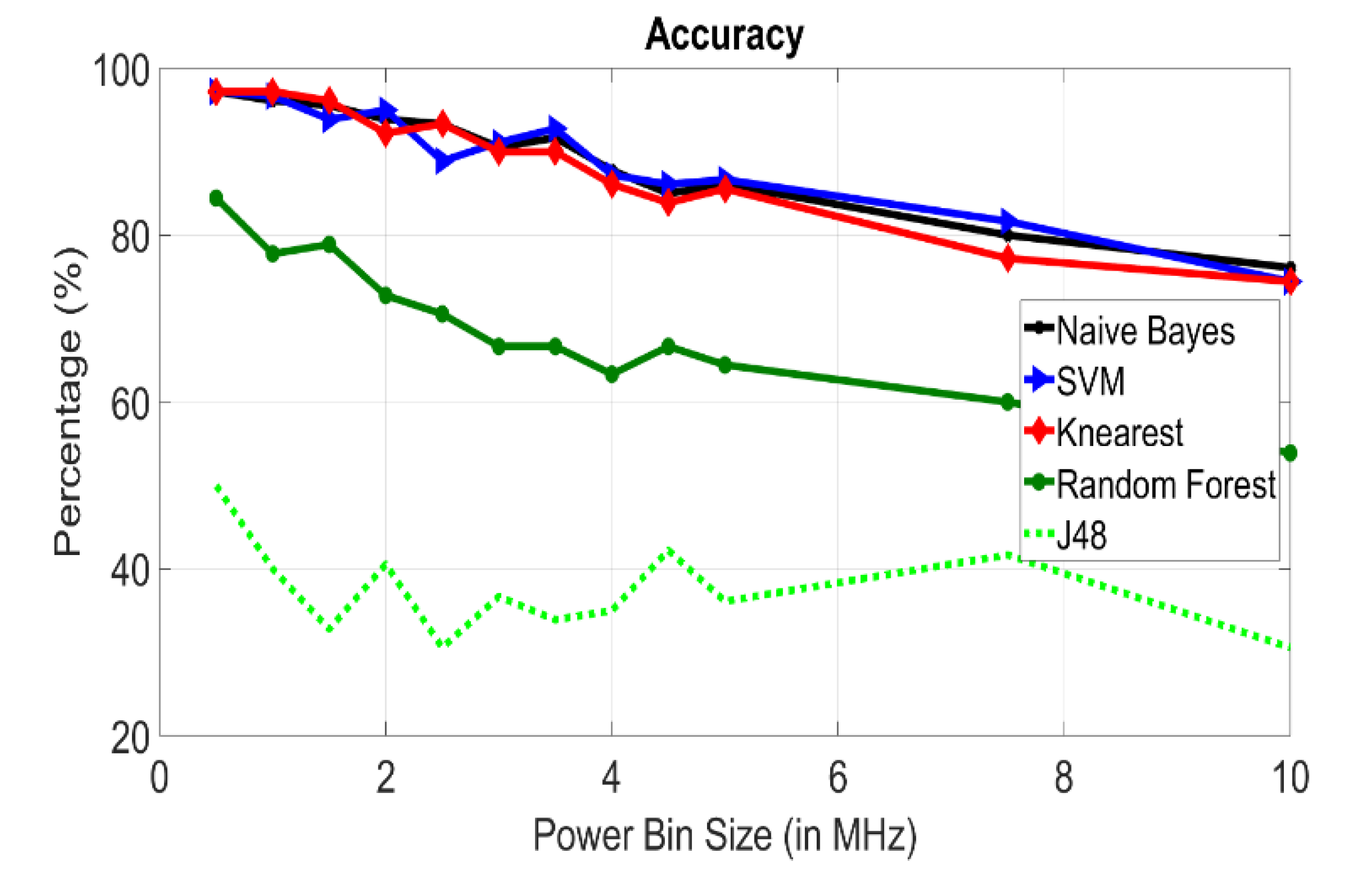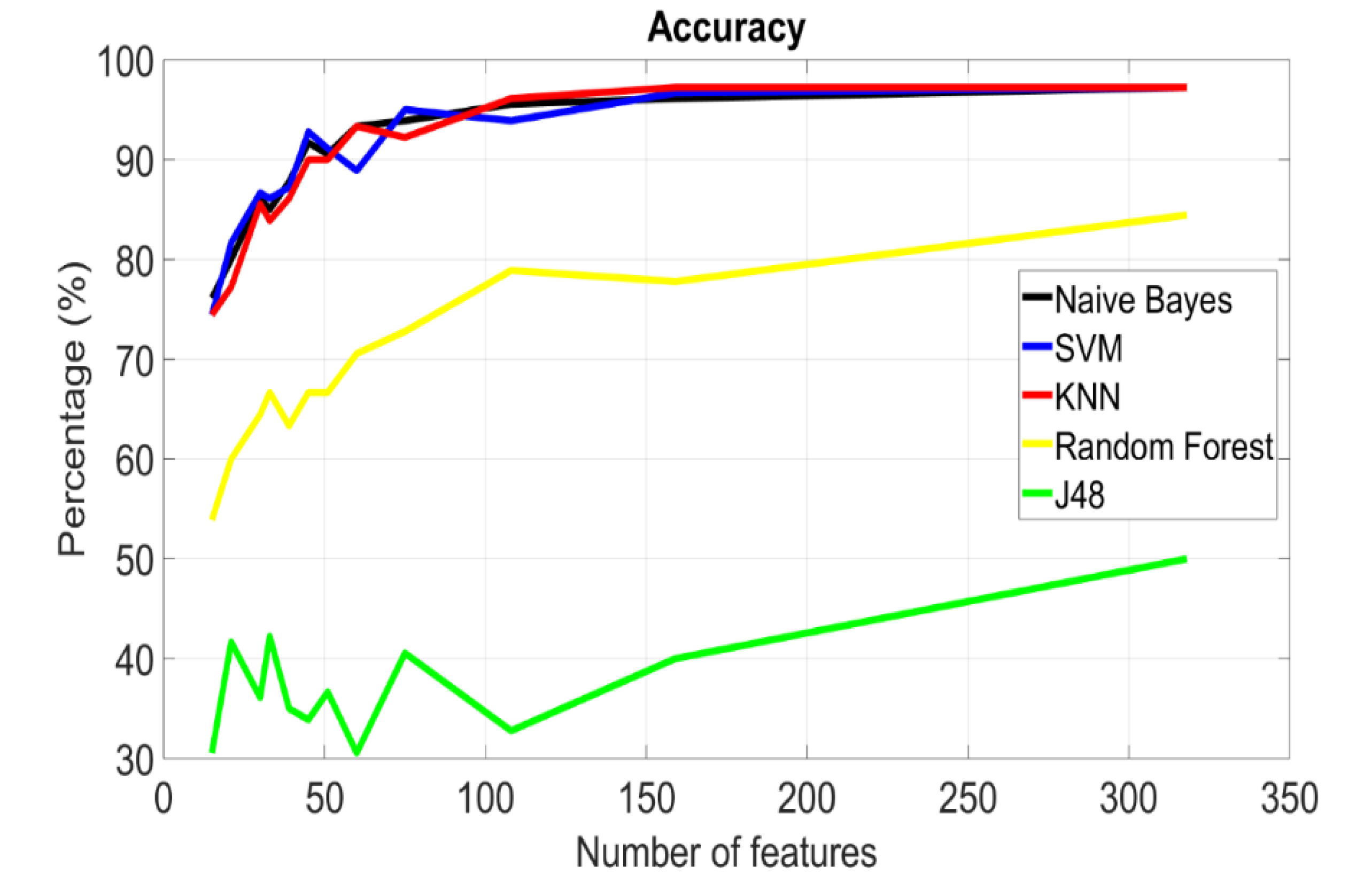Biometric Identity Based on Intra-Body Communication Channel Characteristics and Machine Learning
Abstract
1. Introduction
- (1)
- Study and present a survey on prior work in using IBCs for biometric identity.
- (2)
- Gather experimental data that characterizes the IBC channel characteristics and extract unique and identifying features.
- (3)
- Applying machine learning algorithms on the collected data and features to use the IBC channel characteristics as a biometric identity.
2. Intra-Body Communications
2.1. Introduction
2.2. IBC as a Biometric Identity
3. Proposed Method
- (1)
- An electrical signal is coupled into the body at the transmitter (TX) node, then picked up at the receiver nodes (RX), where the signal is transmitted through the body following the galvanic coupling IBC technique, since both electrodes at each node are connected to the body.
- (2)
- The received signal incorporates information about the channel that it was transmitted through—the body in this case—which is unique for each person and can thus be used as a biometric identifier. This information is mainly based on the channel response (channel transfer function) which is determined mainly by the gain/attenuation channel profile that is developed due to the body’s unique biological and geometrical features, as discussed in [11].
- (3)
- The above procedure would be repeated automatically n times for the calibration of the system, where n is a system parameter. Calibration is required to extract unique features to be able to accurately identify subjects, and to aid at normalizing the features against external factors whose effect should not impact the final unique biometrics, such as: temperature, wind, posture, illumination, etc.
- (4)
- Once the system is calibrated the person’s identity will thus be stored, yet still will be unique and relevant to the specific system (hardware) used, adding an extra layer of security.
- (5)
- Continuous authentication/identification/authorization can then take place, where a predefined signal is then transmitted from the TX node, every specific time interval. This is also one of the major advantages of adopting the proposed biometrics, where the identification/authentication process is done automatically and conveniently, with no need for any physical actions to be taken on the user’s part, as opposed to other techniques like using finger prints.
- (6)
- The received signal is picked up at the RX node and further processed through machine learning algorithms to complete the identification process and verify the identity of the subject, after comparing the received signal with previously recorded identifiers that are unique for that subject.
3.1. Experimental Setup
- (1)
- Using the amplitude of the galvanic channel gain at different frequencies directly as the features, over the whole frequency range, at each TX–RX separation distance separately. In other words, the channel gain/attenuation profile across the galvanic coupling frequency range is used directly to obtain the unique features determining the biometric identity of each individual, yet each set of these features are tested separately against each separation distance.
- (2)
- Use the same approach as 1 but when using all the data for the different TX–RX separations, as different cases; as if different instances with the same unique identifiers (for example the channel response magnitude at 10 MHz is used as the same unique identifier, no matter what the separation is) thus increasing the number of instances that can be used for training and testing the machine learning models by 3× times.
- (3)
- Same as approach 1, but when combining the measurements for all TX–RX separation measurements, not as test cases, but as features (channel response magnitude at 10 MHz for the 10 cm is used as a feature, while the magnitude at 10 MHZ for the 15 cm is used as a different feature, thus for each measurement case, the three separations are combined as a single training/testing instance). In other terms, features obtained from the channel profile when the separation distance for the experimental setup is 10 cm, are used all together with features generated in case of 15 cm and 20 cm at the same time to train and test the identification machine learning models, to check if adding such variations would enhance the model accuracy and performance, through adding extra unique and identifiable information.
- (4)
- Divide the frequency spectrum into bins/segments of equal sizes (example: 1 MHz bin, 5 MHz bin), compute the total power spectral density for the channel response for the frequency components within each bin, then use this value as a single unique feature.
3.2. Machine Learning Algorithms
4. Results
Impact of Bin Size
5. Conclusions
Author Contributions
Funding
Conflicts of Interest
References
- Zimmerman, T.G. Personal Area Network (PAN). Master’s Thesis, MIT Press, Cambridge, MA, USA, 1995. [Google Scholar]
- Handa, T.; Shoji, S.; Ike, S.; Takeda, S.; Sekiguchi, T. A very low power consumption wireless ECG monitoring system using body as a signal transmission medium. In Proceedings of the International Conference on Transducers, Solid-State Sensors Actuators, Chicago, IL, USA, 19 June 1997; pp. 1003–1006. [Google Scholar]
- Ruiz, J.A.; Xu, J.; Shimamoto, S. Propagation characteristics of intra-body communications for body area networks. In Proceedings of the 2006 3rd IEEE Consumer Communications and Networking Conference, Las Vegas, NV, USA, 8–10 January 2006; Volume 1, pp. 509–513. [Google Scholar]
- Hachisuka, K.; Terauchi, Y.; Kishi, Y.; Hirota, T.; Sasaki, K.; Hosaka, H.; Ito, K. Simplified circuit modeling and fabrication of intrabody communication devices. In Proceedings of the 13th International Conference on Solid-State Sensors, Actuators and Microsystems, Seoul, Korea, 5–9 June 2005; pp. 461–464. [Google Scholar]
- Wegmueller, M.S.; Kuhn, A.; Froehlich, J.; Oberle, M.; Felber, N.; Kuster, N.; Fichtner, W. An attempt to model the human body as a communication channel. IEEE Trans. Biomed. Eng. 2007, 54, 1851–1857. [Google Scholar]
- Wegmueller, M.S.; Oberle, M.; Felber, N.; Kuster, N.; Fichtner, W. Signal Transmission by Galvanic Coupling through the Human Body. IEEE Trans. Instrum. Meas. 2010, 59, 963–969. [Google Scholar] [CrossRef]
- Cho, N.; Yoo, J.; Song, S.-J.; Lee, J.; Jeon, S.; Yoo, H.-J. The human body characteristics as a signal transmission medium for intrabody communication. IEEE Trans. Microwave Theory Tech. 2007, 55, 1080–1085. [Google Scholar] [CrossRef]
- Callej, M.A.; Naranjo-Hernandez, D.; Reina-Tosina, J.; Roa, L.M. Distributed circuit modeling of galvanic and capacitive coupling for intrabody communication. IEEE Trans. Biomed. Eng. 2012, 59, 3263–3269. [Google Scholar]
- Kibret, B.; Seyedi, M.; Lai, D.T.H.; Faulkner, M. Investigation of galvanic-coupled intrabody communication using the human body circuit model. IEEE J. Biomed. Health Inform. 2014, 18, 1196–1206. [Google Scholar] [CrossRef] [PubMed]
- Mao, J.; Yang, H.; Lian, Y.; Zhaoi, B. A Five-Tissue-Layer Human Body Communication Circuit Model Tunable to Individual Characteristics. IEEE Trans. Biomed. Circuits Syst. 2018, 12, 303–312. [Google Scholar] [CrossRef] [PubMed]
- Khorshid, A.E.; Eltawil, A.M.; Kurdahi, F. Intra-body communication model based on variable biological parameters. In Proceedings of the 2015 49th Asilomar Conference on Signals, Systems and Computers, Pacific Grove, CA, USA, 8–11 November 2015; pp. 948–951. [Google Scholar]
- Khorshid, A.E.; Alquaydheb, I.N.; Eltawil, A.M. Electrode impedance modeling for channel characterization for intra-body communication. In Advances in Body Area Networks I; Springer: Cham, Switzerland, 2019; pp. 253–266. [Google Scholar]
- Li, M.; Song, Y.; Hou, Y.; Li, N.; Jiang, Y.; Sulaman, M.; Hao, Q. Comparable Investigation of Characteristics for Implant Intra-Body Communication Based on Galvanic and Capacitive Coupling. IEEE Trans. Biomed. Circuits Syst. 2019, 13, 1747–1758. [Google Scholar] [CrossRef] [PubMed]
- Seyedi, M.; Kibret, B.; Lai, D.T.H.; Faulkner, M. A survey on intrabody communications for body area network applications. IEEE Trans. Biomed. Eng. 2013, 60, 2067–2079. [Google Scholar] [CrossRef] [PubMed]
- Wegmueller, M.S.; Huclova, S.; Froehlich, J.; Oberle, M.; Felber, N.; Kuster, N.; Fichtner, W. Galvanic coupling enabling wireless implant communications. IEEE Trans. Instrum. Meas. 2009, 58, 2618–2625. [Google Scholar] [CrossRef]
- Xu, Y.; Huang, Z.; Yang, S.; Wang, Z.; Yang, B.; Li, Y. Modeling and Characterization of Capacitive Coupling Intrabody Communication in an In-Vehicle Scenario. Sensors 2019, 19, 4305. [Google Scholar] [CrossRef] [PubMed]
- Khorshid, A.E. Intra-Body Communications for Body Area Networks Dissertation. Ph.D. Thesis, University of California, Irvine, CA, USA, 2019. [Google Scholar]
- Naranjo-Hernández, D.; Callejón-Leblic, A.; Lučev Vasić, Ž.; Seyedi, M.; Gao, Y.M. Past Results, Present Trends, and Future Challenges in Intrabody Communication; Wireless Communications and Mobile Computing; Hindawi: London, UK, 2018. [Google Scholar]
- Fujii, K.; Takahashi, M.; Ito, K.; Hachisuka, K.; Terauchi, Y.; Kishi, Y.; Sasaki, K. A study on the transmission mechanisfor wearable devices using the human body as a transmission channel. IEICE Trans. Commun. 2005, E88-B, 2401–2410. [Google Scholar] [CrossRef]
- Shinagawa, M. Development of electro-optic sensors for intra-body communications. NTT Tech. Rev. 2004, 2, 6–11. [Google Scholar]
- Shinagawa, M.; Ochiai, K.; Sakamoto, H.; Asahi, T. Human area networking technology: RedTacton. NTT Tech. Rev. 2005, 3, 41–46. [Google Scholar]
- Kado, Y. Red tacton near-body electric-field communications technology and its applications. NTT Tech. Rev. 2010, 8, 1–6. [Google Scholar]
- Nakanishi, I.; Yorikane, Y.; Itoh, Y.; Fukui, Y. Biometric Identity Verification Using Intra-Body Propagation Signal. In Proceedings of the 2007 Biometrics Symposium, Baltimore, MD, USA, 11–13 September 2007; pp. 1–6. [Google Scholar]
- Nakanishi, I.; Inada, T.; Sodani, Y.; Li, S. Performance Evaluation of Intra-palm Propagation Signals as Biometrics. In Proceedings of the 2013 International Conference on Biometrics and Kansei Engineering, Tokyo, Japan, 5–7 July 2013; pp. 91–94. [Google Scholar]
- Martinovic, I.; Rasmussen, K.; Roeschlin, M.; Tsudik, G. Authentication using pulse-response biometrics. Commun. ACM 2017, 60, 108–115. [Google Scholar] [CrossRef]
- MiniVNA PRO. Available online: http://miniradiosolutions.com/minivna-pro/ (accessed on 28 February 2020).
- International Commission on Non-Ionizing Radiation Protection (ICNIRP). Guidelines for Limiting Exposure to Time-Varying Electric, Magnetic, and Electromagnetic Fields (Up to300GHz). 1997. Available online: https://www.icnirp.org/cms/upload/publications/ICNIRPemfgdl.pdf (accessed on 4 March 2020).
- IEEE C95.1-2005. IEEE Standard for Safety Levels with Respect to Human Exposure to Radio Frequency Electromagnetic Fields, 3 kHz to 300 GHz; The Institute of Electrical and Electronics Engineers Inc.: New York, NY, USA, 2006. [Google Scholar]
- Khorshid, A.E.; Alquaydheb, I.N.; Eltawil, A.M.; Kurdahi, F.J. Physical Multi-Layer Phantoms for Intra-Body Communications. IEEE Access 2018, 6, 42812–42821. [Google Scholar] [CrossRef]
- Khorshid, A.E.; Alquaydheb, I.N.; Eltawil, A.M.; Kurdahi, F.J. IBCFAP: Intra-Body Communications Five-Layers Arm Phantom Model. IEEE Access 2019, 7, 93701–93710. [Google Scholar] [CrossRef]
- MATLAB. Available online: https://www.mathworks.com/products/matlab.html (accessed on 28 February 2020).
- Hall, M.; Frank, E.; Holmes, G.; Pfahringer, B.; Reutemann, P.; Witten, I.H. The WEKA data mining software: An update. SIGKDD Explor. Newsl. 2009, 11, 10–18. [Google Scholar] [CrossRef]
- SVM. Available online: https://medium.com/machine-learning-101/chapter-2-svm-support-vector-machine-theory-f0812effc72 (accessed on 28 February 2020).
- C4.5 Algorithm. Available online: https://en.wikipedia.org/wiki/C4.5_algorithm (accessed on 28 February 2020).
- Ho, T.K. Random decision forests. In Proceedings of the 3rd International Conference on Document Analysis and Recognition, Montreal, QC, Canada, 14–16 August 1995; Volume 1, pp. 278–282. [Google Scholar]





| Classifier | Accuracy | Precision | Recall | F-Measure |
|---|---|---|---|---|
| Naïve Bayes | 98.8372% | 0.989 | 0.988 | 0.988 |
| SVM | 95.5% | 0.962 | 0.955 | 0.955 |
| KNN | 100% | 1 | 1 | 1 |
| Random Forest | 96% | 0.962 | 0.960 | 0.959 |
| J48 | 92% | 0.939 | 0.920 | 0.923 |
| Classifier | Accuracy | Precision | Recall | F-Measure |
|---|---|---|---|---|
| Naïve Bayes | 91.9811% | 0.920 | 0.920 | 0.920 |
| SVM | 90.566% | 0.909 | 0.906 | 0.907 |
| KNN | 91.9811% | 0.921 | 0.920 | 0.920 |
| Random Forest | 91.9811% | 0.921 | 0.920 | 0.920 |
| J48 | 81.6038% | 0.827 | 0.816 | 0.818 |
| Classifier | Accuracy | Precision | Recall | F-Measure |
|---|---|---|---|---|
| Naïve Bayes | 71.6102% | 0.740 | 0.716 | 0.691 |
| SVM | 80.5085% | 0.838 | 0.805 | 0.812 |
| KNN | 83.8983% | 0.750 | 0.581 | 0.655 |
| Random Forest | 79.661% | 0.793 | 0.797 | 0.782 |
| J48 | 78.3898% | 0.606 | 0.645 | 0.625 |
| Classifier | Accuracy | Precision | Recall | F-Masure |
|---|---|---|---|---|
| Naïve Bayes | 85.9756% | 0.844 | 0.609 | 0.708 |
| SVM | --- | ---- | ---- | ----- |
| KNN | 89.4817% | 0.894 | 0.895 | 0.894 |
| Random Forest | 87.0427% | 0.870 | 0.870 | 0.868 |
| J48 | 82.3171% | 0.833 | 0.823 | 0.826 |
| Classifier | Accuracy | Precision | Recall | F-Measure |
|---|---|---|---|---|
| Naïve Bayes | 97.9695% | 0.981 | 0.980 | 0.980 |
| SVM | ---- | - | - | - |
| KNN | 96.9543% | 0.970 | 0.970 | 0.970 |
| Random Forest | 97.9695% | 0.981 | 0.980 | 0.980 |
| J48 | 92.3858% | 0.941 | 0.924 | 0.926 |
| Classifier | Accuracy | Precision | Recall | F-Measure |
|---|---|---|---|---|
| Naïve Bayes | 98.4127% | 0.984 | 0.984 | 0.984 |
| SVM | 94.9206% | 0.963 | 0.949 | 0.952 |
| KNN | 97.7778% | 0.978 | 0.978 | 0.978 |
| Random Forest | 87.619% | 0.892 | 0.876 | 0.863 |
| J48 | 47.9365% | 0.750 | 0.479 | 0.512 |
| Description | Recommended Model and Performance | Comments | |
|---|---|---|---|
| Approach 1 | Using the magnitude of channel response at different frequencies as features, considering only the best separation distance | Naïve Bayes (98.8372%) KNN (~100%) | - Achieves high accuracy with simple models, in case of the 10 cm separation. |
| Approach 2 | Same as approach 1, but all the separation distances are used as different training/test cases for the same run (number of train/test cases are 3× that of approach 1) | KNN (89.4817%) Random Forest (87.427%) | - Simple models, yet least accuracy among all approaches |
| Approach 3 | Same as approach one, but channel response at different frequencies and separation distances are all combined as features (3× number of features compared to approach 1 and 2) | Naïve Bayes (97.9695%) Random Forest (97.9695%) | - More complex models (3× number of features) and more computational resources needed. |
| Approach 4 | Use of power Bins as features (integration of power across a frequency spectrum (bin)) | Naïve Bayes (98.4127%) Random Forest (97.7778%) | - High accuracy - More resilient to noise and magnitude variations - Extra features’ pre-processing is needed |
© 2020 by the authors. Licensee MDPI, Basel, Switzerland. This article is an open access article distributed under the terms and conditions of the Creative Commons Attribution (CC BY) license (http://creativecommons.org/licenses/by/4.0/).
Share and Cite
Khorshid, A.E.; Alquaydheb, I.N.; Kurdahi, F.; Jover, R.P.; Eltawil, A. Biometric Identity Based on Intra-Body Communication Channel Characteristics and Machine Learning. Sensors 2020, 20, 1421. https://doi.org/10.3390/s20051421
Khorshid AE, Alquaydheb IN, Kurdahi F, Jover RP, Eltawil A. Biometric Identity Based on Intra-Body Communication Channel Characteristics and Machine Learning. Sensors. 2020; 20(5):1421. https://doi.org/10.3390/s20051421
Chicago/Turabian StyleKhorshid, Ahmed E., Ibrahim N. Alquaydheb, Fadi Kurdahi, Roger Piqueras Jover, and Ahmed Eltawil. 2020. "Biometric Identity Based on Intra-Body Communication Channel Characteristics and Machine Learning" Sensors 20, no. 5: 1421. https://doi.org/10.3390/s20051421
APA StyleKhorshid, A. E., Alquaydheb, I. N., Kurdahi, F., Jover, R. P., & Eltawil, A. (2020). Biometric Identity Based on Intra-Body Communication Channel Characteristics and Machine Learning. Sensors, 20(5), 1421. https://doi.org/10.3390/s20051421




